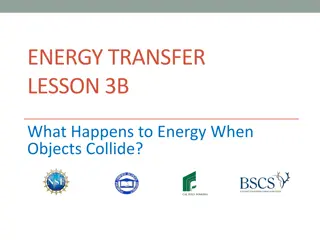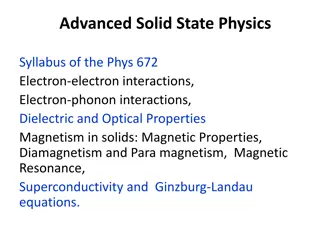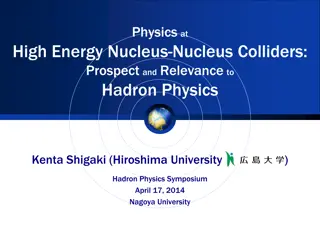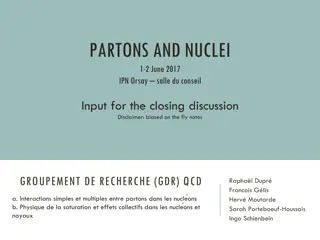Micro-resolution Unidirectional Sensor for Ice Collisions
Develop a micro-resolution unidirectional sensor for detecting ice collisions. The team members include Tim Shaw, Alec Macchia, Cyrus Nichols, Sophia Trissell, Riley Gordon, Bradley Bishop, Tyler Schwinck, Garrett Lycett, and Jarrett Bartson.
0 views • 57 slides
ADAS DRIVER TRAINING
In-cab devices in trucks include an ADAS camera and Driver Feedback Device (DFD) to alert drivers of unsafe conditions like short following, collisions, and lane departures. The DFD enables visual and audible alerts, with options to manually trigger events and adjust volume. Visual and audible alert
2 views • 8 slides
Detector Solenoid Design Overview and Status Update for EIC UG Meeting
Overview of the detector solenoid design presented by Renuka Rajput-Ghoshal from JLab at the EIC UG Meeting. The presentation covers the team members, collaboration process, timeline, and milestones achieved in the design and procurement phases.
0 views • 26 slides
Advanced Microbunched Electron Cooling for EIC Design Overview
Microbunched electron cooling is a cutting-edge technique proposed for the Electron-Ion Collider (EIC) design, aimed at enhancing beam properties through coherent electron interactions. The concept utilizes Coherent Electron Cooling (CeC) and broad-band amplification in the form of Micro-bunched Ele
1 views • 16 slides
Understanding Energy Transfer in Collisions
Exploring what happens to energy when objects collide, this lesson focuses on energy transfer through collisions using engaging models and investigations. Key science ideas such as the relationship between an object's speed and energy are examined, with a detailed analysis of energy movement before,
0 views • 13 slides
Understanding Vehicle Collisions: Causes, Types, and Injuries
Vehicle collisions involve various types such as front impacts, side impacts, and rear-end collisions, resulting in different injuries like back and head injuries, neck injuries, soft tissue damage, broken bones, and internal injuries. Understanding the causes and effects of collisions can help prev
0 views • 14 slides
Study on Collective Flow and Participant Eccentricity in High-energy Heavy-ion Collisions
Explore the research on collective behavior, eccentricity, and flow of final state particles in high-energy heavy-ion collisions. Learn about the measurement of Fourier coefficients, azimuthal angles, and spatial anisotropy, as well as the analysis of system size dependence and radial flow in variou
1 views • 29 slides
Event Structure and Color Reconnection in Heavy Ion Physics
Investigating event structures in proton-proton collisions sheds light on potential relevance for heavy ion physics, especially in understanding parton energy loss and hydrodynamic flow dynamics. The study discusses phenomena like color reconnection, underlying events in Pythia, and multiple-parton
1 views • 31 slides
Production in Collisions at 8-16 TeV: Analysis Overview
Detailed analysis overview of the production in collisions at 8-16 TeV incorporating contributions from Pavel Larionov (ITSsa), Paula Matuoka (TPC), Silvia Pisano (TPC), and Marco Toppi (TOF). The analysis involves the comparison of spectra data to previous datasets, emphasizing the importance of un
0 views • 50 slides
Insight into De-Confinement in High-Energy Nuclear Collisions
Explore the phenomena of de-confinement and clustering of color sources in nuclear collisions, revealing the transition to a state where quarks and gluons cannot be confined into color-neutral hadrons. This study delves into the relationship between percolation theory and de-confinement, shedding li
0 views • 34 slides
Open Heavy-Flavour Production in pp Collisions at the LHC - Physics Seminar Overview
Physics seminar presentation by Francesco Prino on open heavy-flavour production as a function of multiplicity in pp collisions at the Large Hadron Collider (LHC). The talk covers the motivation behind studying heavy-flavour production mechanisms, data analysis techniques, results on the multiplicit
0 views • 65 slides
Exploring Heavy-Ion Collisions at CERN LHC: ALICE Experiment Overview
Unveiling insights into heavy-ion collisions at CERN's Large Hadron Collider (LHC) through the ALICE experiment. Delving into the status, performance, and initial results, ALICE aims to characterize the medium formed during collisions. With a collaboration of around 1000 members from 31 countries an
0 views • 29 slides
Experimental Reconstruction of Primary Hot Fragment in Heavy Ion Collisions
Investigation into primary hot fragment reconstruction at Fermi energy heavy ion collisions, utilizing experimental data and simulations to reconstruct excitation energy, mass, and charge of primary fragments. Techniques like kinematical focusing and isotope identification were employed, with a focu
0 views • 36 slides
Insights into Quarkonium Production in Nuclear Collisions by Dhruv Dixit
Quarkonium mesons, such as Charmonium and Bottomonium, provide crucial information in understanding the effects of nuclear matter on their production in proton-nucleus collisions. These mesons, composed of quark-antiquark pairs, exhibit different behaviors in hot mediums, making them valuable probes
0 views • 11 slides
Understanding Elastic and Inelastic Collisions in Physics
Exploring the concepts of elastic and inelastic collisions, momentum, impulse, and energy conservation in physics. Topics include measuring speed, advantages of airbags, impact of catching objects, and understanding forces in collisions. Images and explanations demonstrate key principles in physics.
1 views • 25 slides
Understanding Linear Momentum and Collisions in Physics
Exploring the concepts of linear momentum, collisions, and conservation of energy in physics, this content covers topics such as momentum definition, conservation laws, impulse, types of collisions, and examples of perfectly inelastic and elastic collisions. It also includes a practical blackboard e
0 views • 17 slides
Correlated Head-Tail Instability in Beam-Beam Collisions
The study discusses the impact of the cross wake force and correlated head-tail instability in collisions with a large crossing angle. It delves into the mechanism of beam-beam instability, cross wake force induction, mode coupling, and particle tracking simulations. Design parameters and instabilit
0 views • 34 slides
Understanding Nucleon Structure: Insights from EIC Workshop
Exploring the mechanics of nucleons and the physics goals of the Electron-Ion Collider (EIC), this content delves into the origin of nucleon mass and spin, emergent properties of dense gluon systems, and energy-momentum tensor in QCD. It discusses the role of gluons in understanding nucleon structur
0 views • 31 slides
Closeout Report: Incremental Design Review of EIC Detector Electronics
Closeout report detailing the progress of the Incremental Preliminary Design and Safety Review of the EIC Detector DAQ and Electronics, along with the Final Design Review of Electronics Components for the ePIC Detector. The report includes responses to charge questions, panel reviews, comments, reco
0 views • 23 slides
Understanding Momentum and Collisions in Physics
Momentum plays a crucial role in analyzing collisions, where objects exert forces on each other over short time intervals. Conservation of momentum, following Newton's laws, allows predicting outcomes in collisions by redistributing momentum among objects. The concept is illustrated through examples
0 views • 25 slides
Comparison of ALOHA, Slotted ALOHA, and CSMA Protocols
ALOHA is a basic protocol where stations can transmit at any time, which leads to collisions. Slotted ALOHA organizes time into slots to reduce collisions and increase efficiency. CSMA uses carrier sensing to avoid collisions. Each protocol has its advantages and limitations in handling network traf
0 views • 17 slides
Understanding Momentum, Impulse, and Collisions in Physics
Learn about momentum, impulse, and collisions in Chapter 8 of physics. Understand how linear momentum, impulse, and the Impulse-Momentum theorem are crucial in analyzing collisions and conservation of momentum. Explore real-world applications in sports and scenarios like a child driving a bumper car
0 views • 19 slides
Fixed Point Collisions in Luttinger Semimetals and Field Theories
Exploring fixed point collisions and tensorial order parameters in Luttinger semimetals and various field theories, such as chiral symmetry breaking in QED and Interacting O(N) field theory. The research delves into the condensed matter motivation behind quadratic band touching and the Luttinger Ham
0 views • 39 slides
Introduction to Drude Model in Solid State Physics
Drude Model, formulated around 1900, explains the fundamental properties of metals such as electricity and heat. It proposes that electrons in metals behave like a classical electron gas, moving freely between atomic cores. The model considers the mean free path between electron collisions and estim
0 views • 39 slides
Insights into LHC Experimental Physics: Lecture Highlights and Challenges
Delve into the world of experimental physics at LHC with lectures by Jon Butterworth at University College London in September 2016. Topics covered include accelerators, detectors, principles, and digressions, along with discussions on triggers, multi-level trigger systems, and collision selection m
0 views • 26 slides
Momentum and Collisions Explained Through Illustrations
Explore various scenarios involving momentum, collisions, and elastic interactions through illustrated examples. Understand concepts such as total momentum in different situations, speeds of masses after collisions, momentum conservation in 1-D and 2-D collisions, and changes in momentum direction.
0 views • 28 slides
Exploring Quark-Gluon Plasma and New State of Matter at High Energy Colliders
Delve into the realm of high-energy physics at nucleus-nucleus colliders, with a focus on the discovery of deconfined partonic matter and the investigation of parallel worlds. Explore the recent insights, emerging topics, and new phenomena observed in ultra-intense collisions. Uncover the properties
0 views • 35 slides
Challenges and Considerations in Electron-Ion Collider Detector Development
Exploring the development of detector systems for Electron-Ion Colliders (EIC) involves addressing various issues such as detector acceptance for low Q2 and high Q2, unique beam characteristics, and the need for specialized components like bend magnets and polarimeters. Key considerations include po
0 views • 16 slides
EIC User Group Steering Committee Plans for Yellow Reports on Physics and Detector Concepts
The EIC User Group Steering Committee is focused on developing Yellow Reports to communicate important physics studies and detector concepts for the Electron-Ion Collider (EIC). These reports aim to advance experimental equipment concepts, complementarity of detectors, and provide input for future T
0 views • 9 slides
Communication Strategies and Reports for Advancing Physics Studies and Detector Concepts at EIC
CERN Yellow Reports provide a platform for sharing impactful work related to CERN, including reports on detectors, technical papers, and new activities. The goal is to advance physics studies and detector concepts in preparation for the EIC, focusing on quantifying physics measurements, implications
0 views • 10 slides
Quarkonium in Medium and Transport in Heavy-Ion Collisions
Discussing the properties and behavior of quarkonium in medium and its transport in heavy-ion collisions. Topics include heavy-quark potential, confinement, quarkonia at finite temperature, quarkonium transport, and quarkonia in heavy-ion collisions. Insightful details about in-medium potential and
0 views • 30 slides
Charm in Heavy Ion Collisions: Experimental Comparisons from SPS to LHC
Investigating charm suppression in heavy ion collisions at different energy levels, this study compares experimental data from SPS to LHC. Analysis suggests similar suppression at SPS and RHIC, with potential factors like recombination and direct J/ψ production influencing results. Uncertainties re
0 views • 16 slides
Cryptographic Algorithms and Hash Collisions Overview
Explore the world of cryptographic algorithms and hash collisions. Learn about various hashing algorithms like MD5, SHA-1, SHA-256, and more. Dive into the concepts of symmetric and asymmetric key algorithms and understand the risks associated with hash collisions. Discover the implications of post-
0 views • 58 slides
LGAD Consortium for EIC: Advancing Detector Technologies
The LGAD Consortium aims to foster the development of detector technologies based on LGAD sensors for the Electron-Ion Collider (EIC) and future projects. By creating a collaborative effort, sharing expertise, and bringing together those interested in LGAD-based detectors, the consortium seeks to ad
0 views • 9 slides
Reconstruction of Nuclear Fragments in EIC e-A Collisions
Investigating nuclear fragment production in EIC e-A collisions through modeling scattering and decay processes using event generators like BeAGLE and FLUKA. Focus is on reconstructing pre-fragments based on nuclei and escaped nucleons, with detectors in far-forward regions aiding in trajectory and
0 views • 22 slides
Exploring Parton and Nucleon Interactions in Hadronic Collisions
Discussions at the GDR QCD workshop covered a range of topics from double parton scattering to coherent processes on nuclei, emphasizing the importance of understanding parton interactions in both proton-proton and heavy ion collisions. Theoretical frameworks such as DPS, SPS, GPDs, and TMDs were ex
0 views • 12 slides
Physics Practice Problems: Collisions and Conservation of Momentum
In this physics practice set, various scenarios of collisions involving objects of different masses and velocities are presented. The problems explore concepts such as momentum conservation and the calculation of final velocities after collisions. Each scenario provides a detailed explanation and so
0 views • 33 slides
Exploring the Versatility of Jets in Hadronization and 3D Imaging at EIC Workshop
Versatile tools in the field of physics, jets play a crucial role in hadronization and 3D imaging. Recent advancements, such as the anti-kT jet reconstruction algorithm, have enhanced the robustness of jet comparisons between theory and experiments. This progress has led to various possibilities lik
0 views • 59 slides
Quarkonia Suppression in High Energy Heavy Ion Collisions by Roland Katz
Investigating the phenomenon of Quarkonia suppression in high energy heavy ion collisions, Roland Katz explores the properties of Quark Gluon Plasma and the behavior of quarks and gluons under extreme conditions. The study delves into the dynamics using the Schrödinger-Langevin equation, highlighti
0 views • 23 slides
Efficient Collaboration Workflow for EIC Software Development
Establishing a critical path for EIC software development, the Software and Computing WG aims for a unified approach. Key tasks include assessing software solutions, proposing recommendations guided by principles, and transitioning to the official framework by October. The procedure outlines a struc
0 views • 13 slides







































